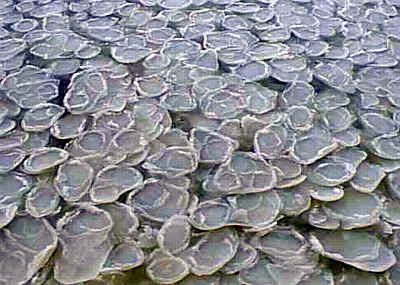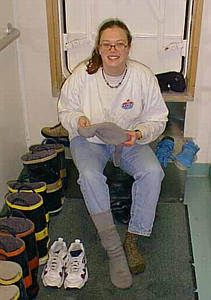
|
|
5 March, 1999
March 5, 1999
Hello from the Walgreen Coast! We have had a great day today. When I
first woke up, I looked outside to see some awesome pancake ice. There
were pancakes for as far as you could see in any direction. Later, the
seas were totally ice-free . . . except for an occassional iceberg that we
drove past. At about noon, I saw the neatest sea ice out the porthole.
It's called nilas. Nilas is a type of ice that's in-between grease ice and
pancake ice. Nilas is a thin (up to 10 cm) elastic crust of floating ice
that bends with the waves. It was really fun to watch. I tried to take a
picture, but it just looks like gray water in the photograph. I've never
seen anything like it in my life!
The night shift collected a very nice seismic profile while they were on
watch, and we've been doing multibeam surveys and coring all day today.
The night shift will continue taking multibeam surveys and cores for most
of tonight, and then we plan to move east toward Pine Island Bay by early
morning. Dr. Anderson says that we are learning a lot from our latest
studies in the Walgreen Coast and Wrigley Gulf. Our surveys are the first
geological studies in this area. We have learned that these areas were
major drainage outlets for the West Antarctic Ice Sheet during the last ice
age. By looking at the deepest parts of the continental shelf, we have
learned that the ice sheet was grounded on rock that is now 1000 meters
below sea level. Because we know this, we can determine the minimum
thickness of the ice sheet at that time in history. As we continue looking
at the sea floor, we hope to determine exactly how far away from the land
that the ice sheet extended. If we can figure that out, we can put all our
information together to estimate what the ice sheet looked like about
20,000 years ago. Hopefully, the cores we are collecting will help us to
determine when and how fast the ice sheet retreated from the continental
shelf.
Well, let's take a look at yesterday's question: "What other types of
animals exist in Antarctica?" There are no land vertebrates in Antarctica.
Even the penguins, seals, and birds that are found around the coast are
technically considered marine animals because they depend on the sea for
their food. There are, however, a few living organisms that can be found
on the continent itself. The largest native land invertebrate on the
Antarctic continent is a tiny, wingless midge that is about 1/4 of an inch
long. There are also several other types of insects that can be found,
which include springtails and tiny mites. Most Antarctic insects live
under rocks and stones in the soil and among lichens. Springtails are
especially common around penguin colonies. They are black and shiny, and
they jump around. No insects in Antarctica have wings, but they all do
have a special "anti-freeze" in their cells that is a lot like the liquid
that we put in our car radiators for the winter. In Antarctica, there are
very few different species of insect. However, in some areas there may be
millions of insects per square yard!
Of course, there are lots of birds around the coast of Antarctica and over
the Southern Ocean. Many varieties of albatross and petrel can be found;
along with shearwaters, gulls, terns, and skuas (to name a few). We have
seen a lot of Antarctic petrels and Snow petrels while on the ship. At
McMurdo Station, we saw lots of South Polar skuas. The South Polar skua is
one of the few species of birds that actually breeds on the Antarctic
continent. It also has the distinction of being the world's most southerly
bird -- at least two have turned up at the South Pole! These birds are
known to fly very far from home. Some South Polar skuas have flown all the
way into the Northern Hemisphere. South Polar skuas are predatory birds
that often feed upon penguins (especially chicks) and other colonial
seabirds. They also feed at sea on Antarctic krill. What other types of
critters, besides krill, can be found in the waters surrounding Antarctica?
We'll look at that in our next journal.
Antarctica also has at least 200 species of lichens, over 100 species of
mosses and liverworts, more than 30 species of macrofungi, 2 species of
flowering plants, and many species of algae. The largest of these plants
are found around the Antarctic Peninsula, where some banks of moss are over
a meter deep. Both types of flowering plants are very small, and they are
restricted to the islands to the west and north of the Antarctic Peninsula.
One of the most unusual plant habitats can be found in Victoria Land.
There, some plants live within large-grained sandstone rocks . . . actually
growing between the sand grains!
Tonight we will be celebrating Hannah's birthday. Everyone has signed a
poster for her, and we also have a card. They will be having birthday cake
at mid-rats (lunch that's served from 11:30 p.m. - 12:30 a.m.). I think
I'll enjoy my piece sometime tomorrow instead of getting up at midnight.
I'm hoping that my journals are not too delayed in getting posted. We have
not been able to receive the satellite signal to upload/download email for
the last 18 hours. I will continue writing journals each day, but there is
no guarantee that they will be sent out each day. We'll do the best we
can. We have also had some problems with email being lost in the black
hole of cyberspace. If you have sent email to me and haven't heard a
response within 48 hours, please resend your email. If we aren't getting
the satellite, the worst that can happen is that I have two copies waiting
for me when we finally do get mail. Probably, however, I never received
your message in the first place. At least we have email communications
that work most of the time. After all, we are in a pretty remote location.
Kim Giesting
Latitude: 73 degrees 40 minutes South
Longitude: 116 degrees 51 minutes West
Temperature: -6.9 degrees C
Barometer: 977.2 mb
Wind Speed: 34.1 knots
Wind Direction: 100 degrees (from the Southeast)
Sunrise: 04:12
Sunset: 19:27

Here's a picture of some of the pancake ice that we saw this morning.

This is PJ after we have finished taking a core. She has just finished taking off her mustang suit and fireman's boots.

Hannah is plotting our latitude and longitude on the map.
Contact the TEA in the field at
.
If you cannot connect through your browser, copy the
TEA's e-mail address in the "To:" line of
your favorite e-mail package.
|
